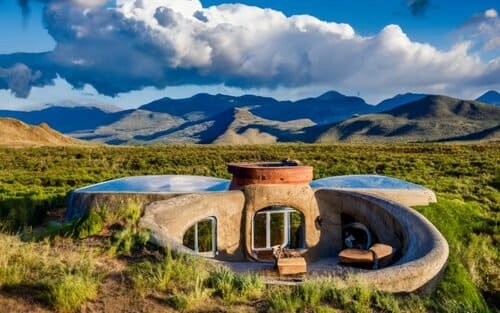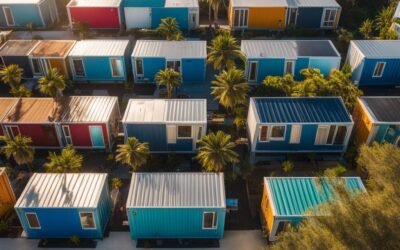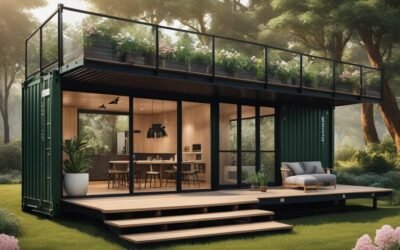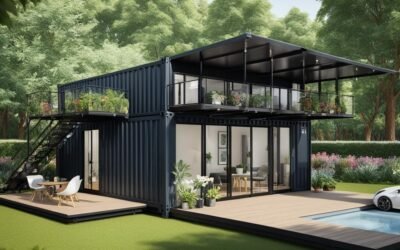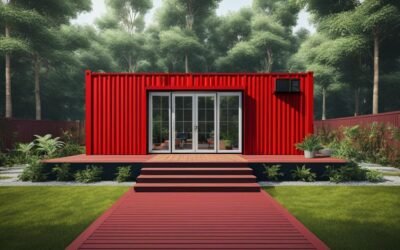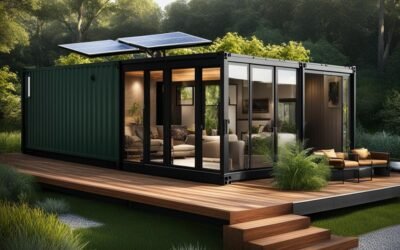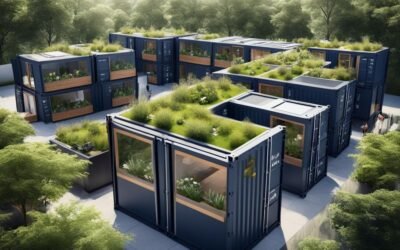Building a container home has become a popular choice for those looking for an affordable and sustainable living option. With the rising cost of housing and the desire to be more eco-conscious, many people are turning to container homes as a way to achieve their dreams of homeownership. In this article, I will take you through my own eco-friendly journey of building a container home, sharing insights, tips, and design ideas along the way. Whether you’re interested in a DIY project or working with professional container home builders, there is plenty of information to help you create your own sustainable and affordable container home.
Key Takeaways
- Building a container home offers an affordable and sustainable housing solution.
- Container homes are a popular choice for those seeking an eco-friendly lifestyle.
- Designing your container home involves considering layout, aesthetics, and sustainability.
- Construction and building tips can help you create a sturdy and environmentally friendly home.
- Proper insulation and energy-efficient systems are essential for comfort and sustainability.
Continue reading the full article to discover more about the journey of building a container home and how you can create an eco-friendly and affordable living space.
Stay tuned for Section 2: Designing Your Container Home.
Designing Your Container Home
The first step in building a container home is designing the layout and choosing the right container for your needs. Consider factors such as the number of containers required, room layouts, and overall aesthetics.
Whether you decide to work with an architect or use container home design software, it’s important to create a plan that maximizes space and functionality while incorporating sustainable design principles. From incorporating recycled or sustainable materials to installing solar panels, there are many ways to make your container home both stylish and eco-friendly.
Key considerations for designing your container home:
- Layout and room placement: Carefully plan the layout of your container home to ensure optimal utilization of space. Think about how you want the rooms to flow and ensure that the overall design accommodates your lifestyle.
- Aesthetics: Choose a design style that aligns with your taste and preferences. Whether you prefer a modern, minimalist look or a cozy, rustic feel, there are endless design possibilities for container homes.
- Sustainable materials: Incorporate recycled or sustainable building materials into your design to reduce your environmental impact. Consider using reclaimed wood for flooring or countertops, or choose eco-friendly insulation options.
- Maximizing natural light: Strategically place windows and skylights to maximize natural light and reduce the need for artificial lighting. This not only improves energy efficiency but also creates a bright and inviting living space.
- Energy-efficient systems: Explore energy-efficient options for heating, cooling, and lighting your container home. From solar panels to LED lighting, there are various ways to reduce your energy consumption and lower your carbon footprint.
Inspiring Container Home Design Ideas
“A well-designed container home combines aesthetics with sustainability, creating a unique and eco-friendly living space.” – John Smith, Container Home Enthusiast.
Looking for inspiration for your container home design? Check out these creative ideas:
- Vertical gardening: Utilize the vertical space by creating a green wall or installing hanging planters. Not only does it add a touch of nature to your container home, but it also helps improve indoor air quality.
- Multi-functional furniture: Optimize space by incorporating multi-functional furniture pieces, such as storage beds or fold-out desks. This allows you to make the most of limited square footage without compromising on style or functionality.
- Open concept living: Create an open and flexible living space by removing unnecessary walls and partitions. This not only makes your container home feel more spacious but also promotes better airflow and natural light.
Remember, designing your container home is an opportunity to unleash your creativity and embrace a sustainable lifestyle. By integrating eco-friendly design elements and thoughtful planning, you can create a container home that is both visually pleasing and environmentally responsible.
| Pros of Container Home Design | Cons of Container Home Design |
|---|---|
| Cost-effective construction | Limited interior space |
| Sustainable and eco-friendly | Permits and zoning challenges |
| Quick assembly and construction | Requires insulation for proper comfort |
| Unique and modern aesthetic | Limited design flexibility |
Construction and Building Tips
 Once you have your design and plans in place, it’s time to start the construction process. Building a container home requires careful consideration of construction techniques and cost-effective methods. Whether you choose to take on the project yourself or work with professional container home builders, here are some tips to ensure a successful and sustainable construction:
Once you have your design and plans in place, it’s time to start the construction process. Building a container home requires careful consideration of construction techniques and cost-effective methods. Whether you choose to take on the project yourself or work with professional container home builders, here are some tips to ensure a successful and sustainable construction:
- Sourcing Local Materials: Look for nearby suppliers and manufacturers to reduce transportation costs and support local businesses. Utilizing reclaimed materials can also add charm and eco-friendliness to your container home.
- Insulation Efficiency: Proper insulation is vital for comfort and energy efficiency. Consider using eco-friendly insulation materials, such as recycled denim or cellulose, to reduce heat loss or gain.
- Energy-Efficient Appliances: Opt for energy-efficient appliances and fixtures to minimize your carbon footprint and save on utility bills. Look for Energy Star-rated appliances and LED lighting options for maximum efficiency.
- Implementing Passive Design: Use passive design principles to optimize natural light, ventilation, and temperature regulation in your container home. This can reduce your reliance on artificial lighting and HVAC systems.
- Consider Water Conservation: Install low-flow fixtures and consider rainwater harvesting systems to minimize water consumption. Efficient water usage not only reduces your ecological impact but also saves you money in the long run.
By following these construction and building tips, you can create a sustainable and affordable container home that aligns with your eco-friendly lifestyle. Now, let’s move on to the next section where we’ll explore the importance of insulation and energy efficiency in container home construction.
Insulation and Energy Efficiency
 Insulation plays a crucial role in container home construction, considering that shipping containers have thin walls and steel is highly conductive. Proper insulation is essential to ensure comfort and energy efficiency in your sustainable container home.
Insulation plays a crucial role in container home construction, considering that shipping containers have thin walls and steel is highly conductive. Proper insulation is essential to ensure comfort and energy efficiency in your sustainable container home.
When it comes to insulation options, there are several eco-friendly choices that can help you create a well-insulated living space. Two popular options are straw bale insulation and cotton-based insulation. Straw bale insulation offers excellent thermal performance and can effectively regulate temperature, while cotton-based insulation provides a sustainable alternative that is free from harmful chemicals.
In addition to traditional insulation methods, incorporating green roofs into your container home design can provide additional insulation benefits. Green roofs, also known as living roofs, consist of a layer of plants and vegetation, which not only helps with insulation but also reduces the overall carbon footprint of your home.
To fully embrace energy efficiency, consider installing energy-saving appliances and implementing renewable energy sources. Solar panels are a great addition to your container home, as they can harness the power of the sun to generate clean and sustainable electricity. By utilizing renewable energy, you can reduce your reliance on traditional power sources and minimize your environmental impact.
Benefits of Insulation and Energy Efficiency
Proper insulation and energy efficiency measures provide several benefits for container homes:
- Enhanced comfort: Insulation ensures that your home retains heat in colder months and keeps cool air in during warmer months, creating a comfortable indoor environment.
- Energy savings: With efficient insulation and energy-saving appliances, you can significantly reduce your energy consumption and lower your utility bills.
- Reduced carbon footprint: By optimizing insulation and incorporating renewable energy, container homes can contribute to a more sustainable future by reducing greenhouse gas emissions.
- Improved durability: Insulation protects your container home from moisture and prevents condensation, which can lead to structural damage and mold growth.
- Noise reduction: Insulation materials with soundproofing properties can help minimize external noise, ensuring a quieter and more peaceful living space.
Investing in insulation and energy efficiency not only benefits the environment but also enhances your overall living experience in your sustainable container home. By utilizing eco-friendly insulation methods and renewable energy sources, you can create a space that is both energy-efficient and environmentally conscious.
Comparison of Insulation Types
| Insulation Type | Advantages | Disadvantages |
|---|---|---|
| Straw Bale | – Excellent thermal performance – Natural, renewable material – Regulates temperature effectively | – Requires careful installation – Vulnerable to moisture if not properly protected |
| Cotton-based | – Sustainable and chemical-free – Provides effective insulation – Does not attract pests or rodents | – Requires professional installation in some cases – May be more expensive than traditional insulation |
Conclusion
Building a container home offers a unique and eco-friendly housing solution. Throughout this article, I have shared insights, tips, and ideas to guide you on your journey of creating a sustainable and affordable container home. Whether you’re embarking on a DIY project or working with container home builders, there are endless possibilities to design a home that not only reflects your personal style but also embraces a greener way of living.
Remember, building a container home is more than just constructing a physical structure; it’s about making conscious choices that contribute to a healthier planet. By incorporating sustainable materials, such as recycled or locally sourced options, you can reduce your carbon footprint and support a more eco-friendly lifestyle. Additionally, consider integrating energy-efficient systems like solar panels and energy-rated appliances to further enhance the sustainability of your container home.
As you embark on your container home journey, take joy in knowing that you’re not only building a unique and stylish dwelling, but you’re also making a positive impact on our environment. Join the growing community of individuals embracing sustainable living and create an eco-friendly home that brings comfort, affordability, and a clearer conscience.
FAQ
What is a container home?
A container home is a dwelling made from shipping containers that have been repurposed for residential use.
Why are container homes considered sustainable?
Container homes are considered sustainable because they repurpose existing materials, reduce construction waste, and can incorporate energy-efficient systems and features.
Can I design my own container home?
Yes, you can design your own container home. There are several design software options available, or you can work with an architect to create a custom design.
How many containers do I need to build a container home?
The number of containers needed will depend on the size and layout of your desired home. It’s best to consult with a professional to determine the right number of containers for your needs.
How can I make my container home more affordable?
There are several ways to make your container home more affordable, such as sourcing local materials, using recycled or salvaged items, and seeking out cost-effective building methods.
What type of insulation should I use for my container home?
There are various insulation options for container homes, including spray foam insulation, rigid insulation panels, and eco-friendly alternatives like straw bales or cotton-based insulation.
Are container homes energy-efficient?
Container homes can be energy-efficient when designed and built with energy-saving features such as solar panels, energy-efficient appliances, and proper insulation.
Can I live off-grid in a container home?
Yes, container homes can be an excellent choice for off-grid living. By incorporating renewable energy systems like solar panels and rainwater harvesting, you can live self-sufficiently in a container home.
Can I hire professional container home builders?
Yes, there are professional container home builders who specialize in constructing container homes. They can help you with the design, build, and customization of your container home.
Can I add a second floor to my container home?
It is possible to add a second floor to a container home, but it will require additional structural considerations and modifications. Consult with a professional to ensure the feasibility and safety of adding a second floor.




